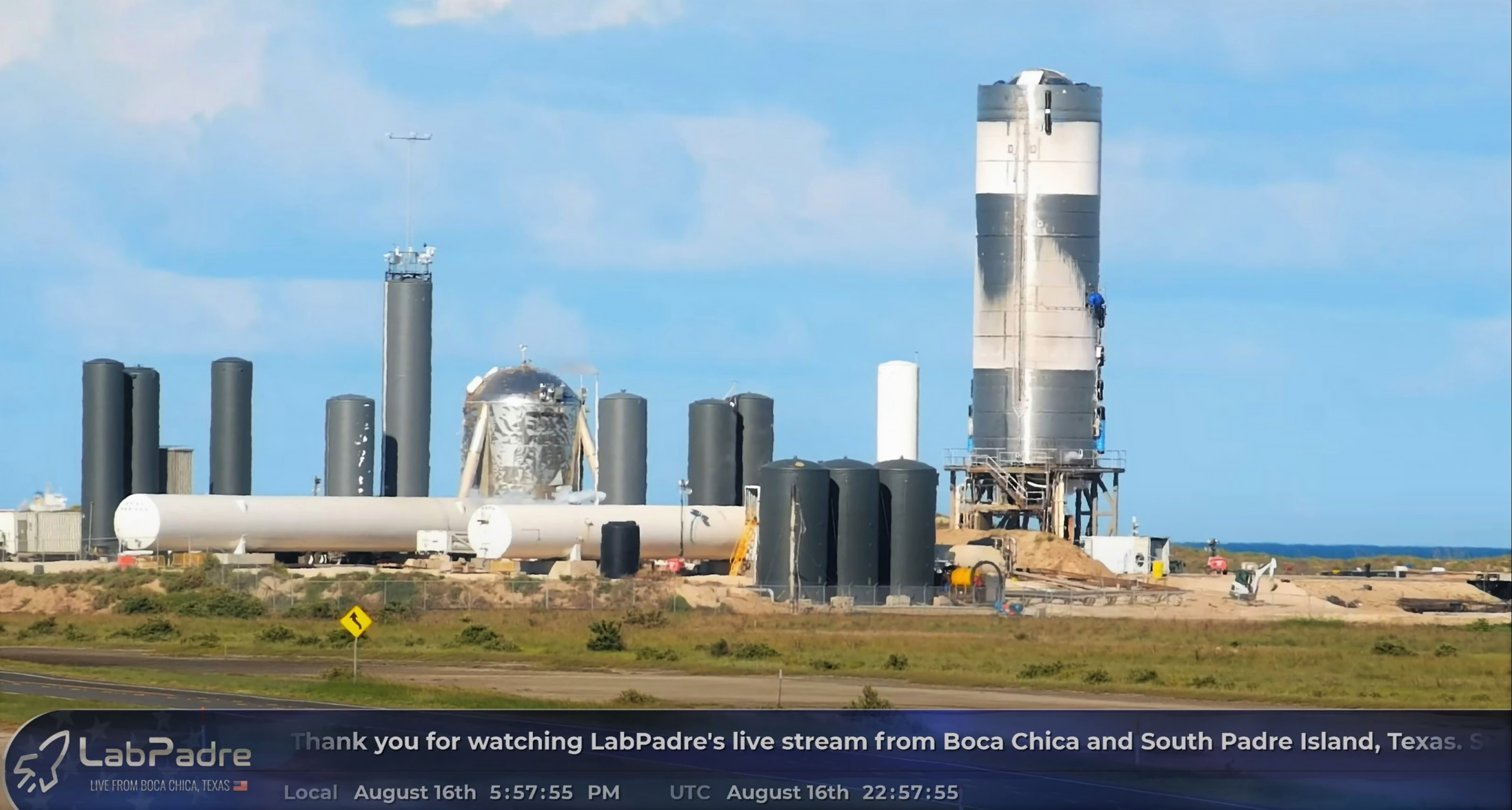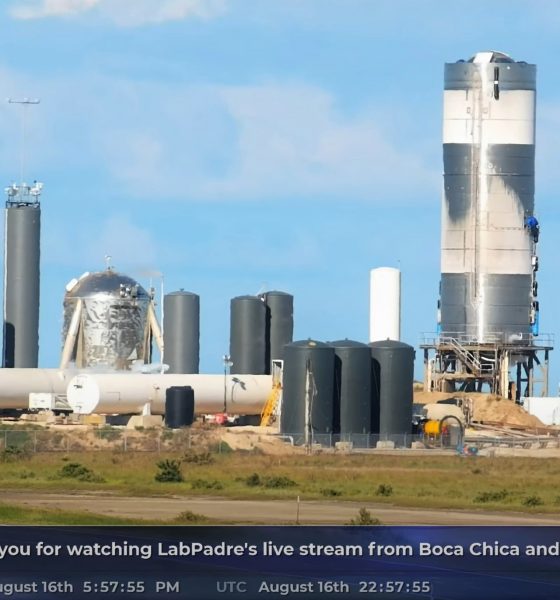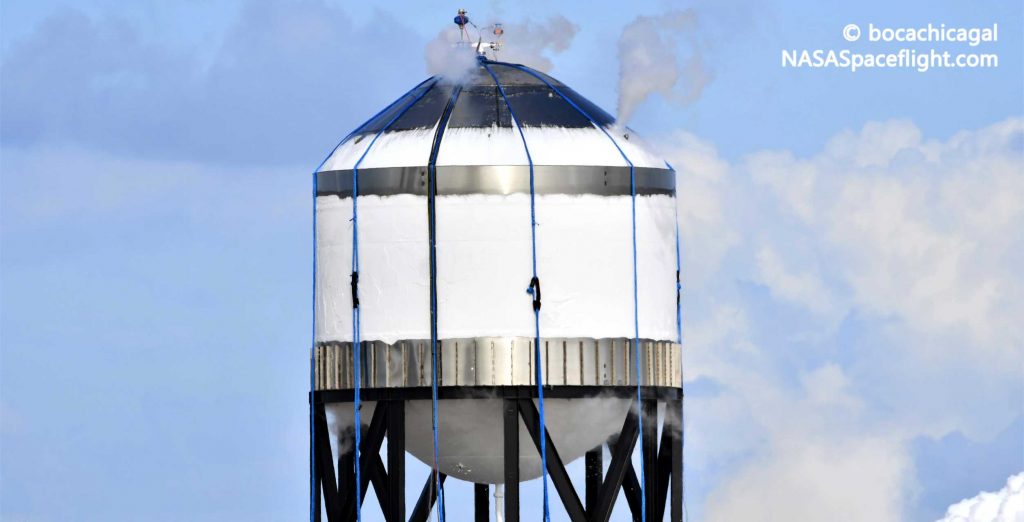

News
SpaceX’s next Starship hop a step closer after ‘cryo proof’ test
SpaceX appears to have successfully completed one of three major tests standing between a new Starship prototype and the rocket’s next hop.
Known as a cryogenic proof test (“cryo proof”), signs currently point towards a success on Starship SN6’s first try – albeit an hour or two past the end of the planned test window. The proof was planned between 8 am and 5 pm CDT (UTC-5) on August 16th with identical backup windows on Monday and Tuesday in the event of an abort or delay. Thankfully, in a breath of fresh air after many Starship SN5 test delays, SpaceX had no such need.
With the help of local sheriffs, SpaceX closed the highway around 10:15 am and pressurized Starship SN6 with ambient-temperature gas (likely nitrogen) around half an hour later. As usual, the company took its time while the Starship prototype effectively came to life for the first time. Around 2.5 hours later, the Starship began visibly venting for the first time as it operated dozens of valves to maintain safe tank pressures.
To perform a cryogenic pressure test, SpaceX effectively performs a wet dress rehearsal (WDR) – a test that simulates a full launch flow short of liftoff – with no engine installed. To prevent leaks or hull breaches from turning potentially catastrophic during what is often the first major test of a prototype, SpaceX loads Starship with liquid nitrogen (LN2) instead of liquid methane and oxygen propellant. During that process, Starship’s thin steel skin will quickly drop to arctic temperatures, becoming cold enough that it will literally freeze the water vapor out of any ambient air it comes in contact with.

Around 1 pm local, the first sign of that frost sheath appeared but remained a sliver before disappearing around 2 pm. Starship SN6 then hung around for an hour before testing activities appeared to restart. Close to 5:40 pm, almost an hour after SpaceX’s August 16th window was meant to close, frost reappeared on Starship SN6’s hull and rapidly crept up the side of the massive rocket.
Starship SN5’s own cryo proof test – completed on June 30th – debuted apparent upgrades to SpaceX’s South Texas launch facilities, loading the rocket with hundreds of thousands of gallons of LN2 in 15-20 minutes. The ability to load huge quantities of cryogenic propellant very quickly will be critical for SpaceX, as Starship’s efficiency will decrease substantially as its propellant warms. Along those lines, Starship SN6 became the second prototype to be rapidly loaded with liquid nitrogen, going from nearly empty to nearly full in ~15 minutes.
SN6 detanked over the next hour or so and SpaceX opened the road and had a team back on the pad to inspect the rocket by 7:40 pm. At some point during the test, SpaceX likely actuated hydraulic arms attached to Starship’s engine section to simulate the stresses of Raptor thrust under cryogenic loads. Either way, SpaceX was apparently satisfied with the results of Starship SN6’s first cryo proof and proceeded to cancel two backup windows scheduled on August 17th and 18th – a consistent sign that things either went very right or very wrong.

In the case of SN6, nothing was distinctly amiss or different during its cryo proof, pointing towards a successful test. If that’s the case, SpaceX will begin removing the hydraulic Raptor simulator to install an actual Raptor engine and will scheduled road closures for an imminent static fire test. Prior to that actual Raptor ignition test, SpaceX may choose to perform a wet dress rehearsal (WDR) on its own or partially test Raptor by igniting its preburners to momentarily spin up its turbopumps. The company could also integrate both of those precursor tests into the same window as the static fire itself.
If those tests go according to plan, Starship SN6 could be ready for SpaceX’s second full-scale hop ever just a week (or less) later. CEO Elon Musk says that the company’s current goal is to perform multiple Starship tests until the process is fast, smooth, and consistent.
Check out Teslarati’s Marketplace! We offer Tesla accessories, including for the Tesla Cybertruck and Tesla Model 3.

Elon Musk
Elon Musk’s X will start using a Tesla-like software update strategy
The initiative seems designed to accelerate updates to the social media platform, while maintaining maximum transparency.

Elon Musk’s social media platform X will adopt a Tesla-esque approach to software updates for its algorithm.
The initiative seems designed to accelerate updates to the social media platform, while maintaining maximum transparency.
X’s updates to its updates
As per Musk in a post on X, the social media company will be making a new algorithm to determine what organic and advertising posts are recommended to users. These updates would then be repeated every four weeks.
“We will make the new 𝕏 algorithm, including all code used to determine what organic and advertising posts are recommended to users, open source in 7 days. This will be repeated every 4 weeks, with comprehensive developer notes, to help you understand what changed,” Musk wrote in his post.
The initiative somewhat mirrors Tesla’s over-the-air update model, where vehicle software is regularly refined and pushed to users with detailed release notes. This should allow users to better understand the details of X’s every update and foster a healthy feedback loop for the social media platform.
xAI and X
X, formerly Twitter, has been acquired by Elon Musk’s artificial intelligence startup, xAI last year. Since then, xAI has seen a rapid rise in valuation. Following the company’s the company’s upsized $20 billion Series E funding round, estimates now suggest that xAI is worth tens about $230 to $235 billion. That’s several times larger than Tesla when Elon Musk received his controversial 2018 CEO Performance Award.
As per xAI, the Series E funding round attracted a diverse group of investors, including Valor Equity Partners, Stepstone Group, Fidelity Management & Research Company, Qatar Investment Authority, MGX, and Baron Capital Group, among others. Strategic partners NVIDIA and Cisco Investments also continued support for building the world’s largest GPU clusters.
News
Tesla FSD Supervised wins MotorTrend’s Best Driver Assistance Award
The decision marks a notable reversal for the publication from prior years, with judges citing major real-world improvements that pushed Tesla’s latest FSD software ahead of every competing ADAS system.

Tesla’s Full Self-Driving (Supervised) system has been named the best driver-assistance technology on the market, earning top honors at the 2026 MotorTrend Best Tech Awards.
The decision marks a notable reversal for the publication from prior years, with judges citing major real-world improvements that pushed Tesla’s latest FSD software ahead of every competing ADAS system. And it wasn’t even close.
MotorTrend reverses course
MotorTrend awarded Tesla FSD (Supervised) its 2026 Best Tech Driver Assistance title after extensive testing of the latest v14 software. The publication acknowledged that it had previously criticized earlier versions of FSD for erratic behavior and near-miss incidents, ultimately favoring rivals such as GM’s Super Cruise in earlier evaluations.
According to MotorTrend, the newest iteration of FSD resolved many of those shortcomings. Testers said v14 showed far smoother behavior in complex urban scenarios, including unprotected left turns, traffic circles, emergency vehicles, and dense city streets. While the system still requires constant driver supervision, judges concluded that no other advanced driver-assistance system currently matches its breadth of capability.
Unlike rival systems that rely on combinations of cameras, radar, lidar, and mapped highways, Tesla’s FSD operates using a camera-only approach and is capable of driving on city streets, rural roads, and freeways. MotorTrend stated that pure utility, the ability to handle nearly all road types, ultimately separated FSD from competitors like Ford BlueCruise, GM Super Cruise, and BMW’s Highway Assistant.
High cost and high capability
MotorTrend also addressed FSD’s pricing, which remains significantly higher than rival systems. Tesla currently charges $8,000 for a one-time purchase or $99 per month for a subscription, compared with far lower upfront and subscription costs from other automakers. The publication noted that the premium is justified given FSD’s unmatched scope and continuous software evolution.
Safety remained a central focus of the evaluation. While testers reported collision-free operation over thousands of miles, they noted ongoing concerns around FSD’s configurable driving modes, including options that allow aggressive driving and speeds beyond posted limits. MotorTrend emphasized that, like all Level 2 systems, FSD still depends on a fully attentive human driver at all times.
Despite those caveats, the publication concluded that Tesla’s rapid software progress fundamentally reshaped the competitive landscape. For drivers seeking the most capable hands-on driver-assistance system available today, MotorTrend concluded Tesla FSD (Supervised) now stands alone at the top.
News
Elon Musk’s Grokipedia surges to 5.6M articles, almost 79% of English Wikipedia
The explosive growth marks a major milestone for the AI-powered online encyclopedia, which was launched by Elon Musk’s xAI just months ago.

Elon Musk’s Grokipedia has grown to an impressive 5,615,201 articles as of today, closing in on 79% of the English Wikipedia’s current total of 7,119,376 articles.
The explosive growth marks a major milestone for the AI-powered online encyclopedia, which was launched by Elon Musk’s xAI just months ago. Needless to say, it would only be a matter of time before Grokipedia exceeds English Wikipedia in sheer volume.
Grokipedia’s rapid growth
xAI’s vision for Grokipedia emphasizes neutrality, while Grok’s reasoning capabilities allow for fast drafting and fact-checking. When Elon Musk announced the initiative in late September 2025, he noted that Grokipedia would be an improvement to Wikipedia because it would be designed to avoid bias.
At the time, Musk noted that Grokipedia “is a necessary step towards the xAI goal of understanding the Universe.”
Grokipedia was launched in late October, and while xAI was careful to list it only as Version 0.1 at the time, the online encyclopedia immediately earned praise. Wikipedia co-founder Larry Sanger highlighted the project’s innovative approach, noting how it leverages AI to fill knowledge gaps and enable rapid updates. Netizens also observed how Grokipedia tends to present articles in a more objective manner compared to Wikipedia, which is edited by humans.
Elon Musk’s ambitious plans
With 5,615,201 total articles, Grokipedia has now grown to almost 79% of English Wikipedia’s article base. This is incredibly quick, though Grokipedia remains text-only for now. xAI, for its part, has now updated the online encyclopedia’s iteration to v0.2.
Elon Musk has shared bold ideas for Grokipedia, including sending a record of the entire knowledge base to space as part of xAI’s mission to preserve and expand human understanding. At some point, Musk stated that Grokipedia will be renamed to Encyclopedia Galactica, and it will be sent to the cosmos.
“When Grokipedia is good enough (long way to go), we will change the name to Encyclopedia Galactica. It will be an open source distillation of all knowledge, including audio, images and video. Join xAI to help build the sci-fi version of the Library of Alexandria!” Musk wrote, adding in a later post that “Copies will be etched in stone and sent to the Moon, Mars and beyond. This time, it will not be lost.”








